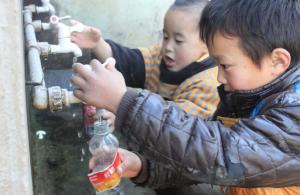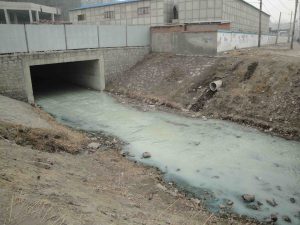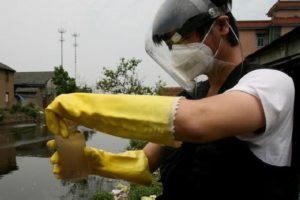China's central government set ambitious goals to safeguard water quality in 2011, at the outset of the 12th Five Year Plan (2011-2015). It targeted improvements from source-to-tap, earmarking a budget of nearly RMB 700 billion (US$112 billion) to pay for upgrades to water treatment and piping systems. The funds were spread across multiple ministries and top level government bodies, including the State Council, the National Development and Reform Commission, the Ministry of Water Resource, the Ministry of Environment Protection, the Ministry of Housing and Urban-Rural Development and the Ministry of Health.
Big goals
Separately, there was also a movement to lift and standardise the varying levels of provincial drinking water quality by introducing a new national standard. In 2007, a National Drinking Water Quality Standard’ (GB 5749-2006) was introduced. This standard is accordance with international standards, but since the bar was set far above the actual quality levels of China’s water, it only came into full effect in July 2012. The government expects cities across China to meet this national standard by 2015.
2015 has arrived. How far is China's government from realizing its water safety goals?
In 2010, over 600 million urban residents already enjoyed access to public water supply services, and more than 400 million rural residents had access to clean drinking water. This was primarily due to government-led improvements in water supply and safe drinking water initiatives. However, 298 million rural Chinese lacked safe drinking water. They were to get supplies during the 2011-2015 Plan. For urban residents, the stated public water supply penetration rate was to rise from 90% to 95%.
Questionable quality
Whilst it is clear that more people across China are enjoying access to public water supply, what is not clear is the quality of the water delivered. The mid-term evaluation of the 12FYP, which started in mid-2013 may have the answers. However, the assessment report is “classified” and has not yet been made available to the public.
In the wake of the anticipated ‘Water Pollution Prevention and Control Action Plan’, which prioritizes drinking water safety, China Water Risk and chinadialogue have taken a closer look into the actual status of urban and rural drinking water in China. The report finds that some urban water quality is still unreliable, while rural areas face many challenges in meeting requirements that are less stringent than in urban areas.
The full report, which sets out issues in water source protection, water financing and water governance, China’s Long March to Safe Drinking Water, is expected to be published later this month.
Drinking water is at the end of the water supply chain. It follows that to achieve high drinking water quality requires comprehensive standards, policies and regulations to be in place, governing the entire supply chain from source-to-tap. Water source protection was included in the China’s ambitious plan to safeguard safe drinking water in the 12thFYP, and targets set for both 2015 and 2020.
For water treatment and main-pipe network management, China is locked into a ‘technology-focused’ path, and is looking at high-tech innovation and infrastructure investment to ensure water quality and delivery.
However, problems persist in secondary water supply to the end user, which has the greatest direct impact on tapwater water quality. Despite many attempts across the country to address this, there is still no perfect solution.
Macro-level success
Many insiders with access to water quality data and information at ministry and department level share a common view of China’s water problems.
They say that in provincial capitals and big cities in developed eastern coastal regions, water safety “essentially has no problems.” In second and third-tier cities as well as medium to small towns, water safety development is “patchy”, but has been improving. In rural areas, there has been rapid progress with collective water supply. Problems with the “Three Highs”, namely high concentrations of fluorine, arsenic and salt found in water in some rural areas, have largely been resolved. Meanwhile, rural drinking water improvement works to stem pollution are also progressing.
In this portrait of China’s drinking water safety landscape, improvement in water quality have been radiating out from the big cities to smaller cities and towns. In reality, however, information on rural areas remains limited; the rural waterscape is shrouded in fog.
Furthermore, beyond this largely positive macro-level overview of China’s drinking water safety, on a local level the real status of water safety in each city, town, county or village remains unclear. Official information disclosure on water quality is poor, and the government keeps official tests and monitoring data secret. Although water supply enterprises have been publishing their water quality test data, there is room for improvement in test frequency, the number of published indicators and public interfaces.
Local concerns
Against this backdrop, civil society groups have resorted to self-testing drinking water to obtain water quality data. A recent report from China Water Safety Foundation shows that only half of the 29 big and medium sized cities it surveyed passed the test on all 20 selected indicators from the National Drinking Water Standard; one city failed the tests on 4 indicators. These test results, together with all other civic monitoring actions, do not give a comprehensive picture of drinking water safety, but they are enough to point out the risks and challenges ahead.
The health and environmental implications of unsafe water are already evident. In some cases, the health impacts have geological causes due to naturally occurring arsenic, fluorine and salt. But elsewhere, they result from human activity and pollution.
In recent years, Persistent Organic Pollutants (POPs), environmental hormones and other toxic organic pollutants have been detected in drinking water, causing widespread public concern. These chemicals are not yet effectively monitored, partly because not enough research has been undertaken on the health impacts when they are absorbed through drinking water.
As the report points out, many obstacles need to be addressed in China’s long march to safe drinking water. China faces problems of ambiguous ownership, unclear water pricing mechanisms, immature market mechanisms and a lack of rural business models, among other issues. There are also governance challenges with dispersed and overlapping responsibilities among various departments across ministries.
Given the current situation of “nine dragons managing water“, many people are expecting to see reforms to the government's administrative systems for water management. This would mean establishing a water management and coordination mechanism across different government bodies. A drinking water monitoring system at both national and local levels is clearly required, as are a water quality technology framework from source-to-tap; supervision and early warning systems; and integrated watershed management. The report suggests these needs should be addressed in the coming ‘Water Pollution Prevention and Control Action Plan’.






